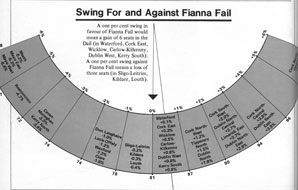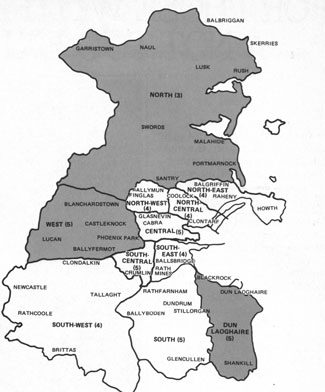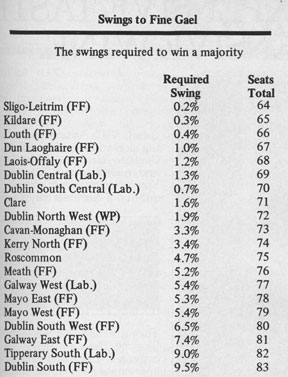The Battleground
There is an inbuilt bias in the constituency size and boundary redrawing of 1980 in favour of Fine Gael.
While Fianna Fail needs a clear 48% of the first preference vote to attain an overall majority, it seems on analysis that' Fine Gael would require only about 46.8% and perhaps even marginally less.
This discrepancy comes about entirely by accident in a constituency revision plan devised by the commission chaired by Justice Brian Walsh in 1980. The major significance of that redrawing was to limit the surplus which the larger parties enjoy in terms of percentage seats over votes - for instance in 1969 Fianna Fail won 52% of the seats with only 45.7% of the first preference vote, while in the February election of this year Fianna Fail took only 48.8% of the seats with 47.3% of the vote.
But the merest swing in its favour would give Fianna Fail a healthy majority on its own - a 1 % swing would result in it gaining 6 seats to bring its total to 87 out of 166.
The polls suggest that there will be a decline in the Fianna Fail vote, so that given the absence of surplus in the constituency arrangement, this would almost certainly mean that it would lose seats and be unable to form a government. It must be emphasised however that the polls serve only to indicate a trend of opinion over the last few months, that they contain a sizeable "don't know" element and that there is a margin of error of plus or minus about three percentage points. There is also the consideration that opinion is likely to swing one way or another during the course of the campaign, so no predictions!
The accompanying charts show the swings towards and away from Fianna Fail which are necessary to effect changes in seats. Another chart shows how the Fine Gael seat compliment will increase with swings to it. Fine Gael needs a massive 9.5% swing to it to get an overall majority (84 seats) on its own. This seems highly improbable but with Irish politics proving so volatile of late, not even this prospect must be ruled out.

All the swings are calculated on the basis of the last effective count. It is the last effective count, not the first count, that determines how seats will be allocated. For instance in a given constituency where, say, Fianna Fail would require 50% of the vote to take three seats out of five, they could get just 42% of the first preference vote but with transfers bring its vote up to 49% on the last effective count. It would therefore require just a swing of 1 % to it to take three seats - not 8% as the first preference vote figure would suggest.


